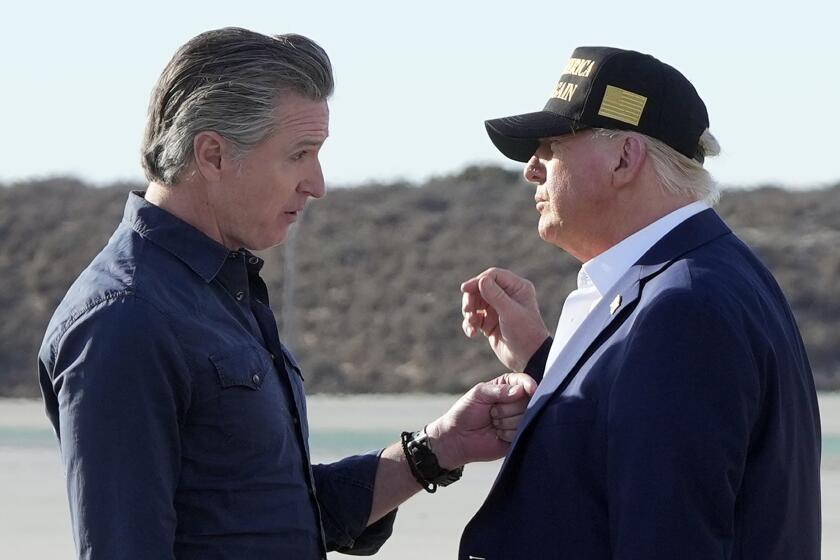BODY WATCH : FITNESS : Weights Can Really Give You a Lift
- Share via
You’ve put your hand weights near the refrigerator, on the bed or in another conspicuous place, vowing to pump a little iron before the day is done.
Strength training is an oft-neglected but important part of an exercise routine. Study after study has sung its praises, even for exercisers past 90.
One of the latest, published in the Journal of the American Medical Assn., found that older women who pump iron improve muscle and bone mass and feel stronger in as little as a month. Other research suggests weight training reduces the risk of colon cancer and diabetes.
Then there’s the purely cosmetic plus--looking buff.
The trick, of course, is sticking with the program. Here, experts tell how to persevere.
*
Focus-on-the-Benefits Tact: Seeing results can keep people faithful, says Miriam Nelson, a Tufts University exercise physiologist who conducted the JAMA study.
Twenty women, ages 50-70, strength trained twice a week for 45 minutes and noticed results within four weeks. They did hip extensions, knee and back extensions, lateral pulldowns and abdominal exercises. They needed no nagging to continue during the one-year study, Nelson says.
“Within four weeks, there were some big differences in how strong they felt,” Nelson reports.
Some told her they felt they had turned back the clock by 20 years. The women kept increasing the resistance and setting short-term goals, which Nelson sees as vital strategies.
“A lot of these women became stronger than their husbands,” Nelson adds, and they found it a source of amusement.
The women increased their muscle mass and bone mass, improved their balance and strength, and were more motivated to be physically active.
On the other hand, the 19 women in the control group lost bone and muscle mass, reported less strength and balance, and were less likely to be physically active.
*
The Tailor-Made Approach: Concentrate on building up the muscles that will improve performance in your regular aerobic routine or favorite sport, suggests Rudy Hayek, a Los Angeles exercise physiologist and fitness consultant.
This “sports-specific training” approach keeps many faithful.
Tennis players, for instance, should work on improving trunk strength and rotation mobility, performing pulldowns and abdominal strength training while in the gym. Runners could do hamstring curls and lunges. Race walkers could aim to strengthen upper-body muscles, such as shoulders, biceps and upper back, which are involved in brisk walking movements.
*
The Forgiving Approach: “Don’t make it a rigid, can’t-miss” kind of obligation, West Los Angeles trainer Todd Person tells his clients. Instead, he suggests, tell yourself you’ll log 10 weight-training sessions a month to make a difference.
“Don’t get into such a strict routine,” advises Person, who often sees the duty-bound burn out quickly. “Go in with a couple of different (workout) menus. Have them written down.”
*
The Options: Several alternatives to traditional weight training have emerged recently.
Super Slow Protocol, for instance, is a system that recommends lifting and lowering the weights at a slower pace than usual, says Ken Hutchins, a fitness expert who helped develop the Nautilus weight-training machines and more recently developed the slower system.
While traditional weightlifting involves a lifting (positive) motion of about two seconds and a releasing (negative) motion of about four, Hutchins now advises taking about 10 seconds to lift and five to release.
This slower approach reduces the likelihood of injury, Hutchins finds, and keeps the muscle loaded, thereby giving quicker results.
“Slower is better,” agrees Bill Livingston, an Alabama fitness expert who developed another slow-motion weight-training system called Concentrated Movement.
Systematic T.O.U.C.H Training, another approach, “helps you make the connection between mind and muscle,” says Beth Rothenberg, the West Los Angeles personal trainer who developed it.
Working with a trainer or by oneself, the approach involves touching the muscle being worked to be sure that you are working intensely enough. “It lets you know you are hitting the target muscle,” Rothenberg says. “It gives faster results.”
* Doheny cannot answer mail personally but will attempt to respond in this column to questions of general interest. Please do not telephone. Write to Fitness, Life & Style Section, Times Mirror Square, Los Angeles, Calif. 90053.






